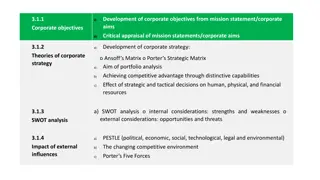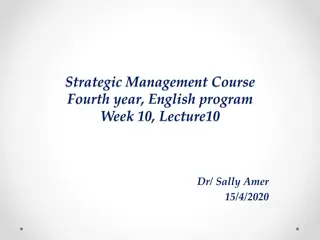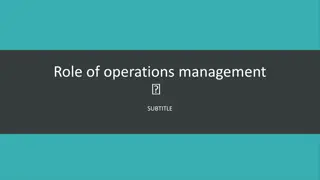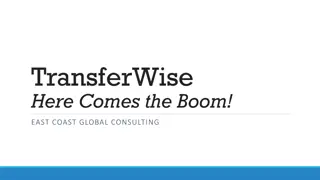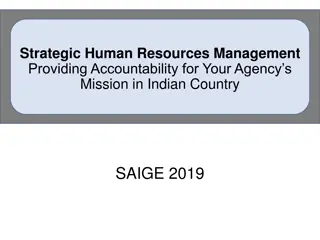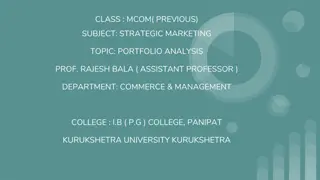Strategic Analysis Techniques in Management
Strategic analysis involves researching a company's environment to formulate effective strategies. Key methods include SWOT analysis, PEST analysis, Porter's five forces, and more. These techniques aid in decision-making and organizational planning.
Download Presentation

Please find below an Image/Link to download the presentation.
The content on the website is provided AS IS for your information and personal use only. It may not be sold, licensed, or shared on other websites without obtaining consent from the author.If you encounter any issues during the download, it is possible that the publisher has removed the file from their server.
You are allowed to download the files provided on this website for personal or commercial use, subject to the condition that they are used lawfully. All files are the property of their respective owners.
The content on the website is provided AS IS for your information and personal use only. It may not be sold, licensed, or shared on other websites without obtaining consent from the author.
E N D
Presentation Transcript
Techniques in Strategic Analysis Strategic Management
Strategic Analysis Strategic analysis refers to the process of conducting research on a company and its operating environment to formulate a strategy. ... Identifying and evaluating data relevant to the company's strategy. Defining the internal and external environments to be analysed. It is essential to formulate strategic planning for decision making and smooth working of that organization
The most well known examples of analytical methods used in strategic analysis are SWOT analysis. PEST analysis. Porter's five forces analysis. Four corner's analysis. Value chain analysis. Early warning scans. War gaming. The Blue Ocean Strategy.
SWOT SWOT analysis (or SWOT matrix) is a strategic planning technique used to help a person or organization identify strengths, weaknesses, opportunities, and threats related to business competition or project planning. It is designed for use in the preliminary stages of decision-making processes and can be used as a tool for evaluation of the strategic position of a city or organization.
SWOT Strengths: characteristics of the business or project that give it an advantage over others. Weaknesses: characteristics of the business that place the business or project at a disadvantage relative to others. Opportunities: elements in the environment that the business or project could exploit to its advantage. Threats: elements in the environment that could cause trouble for the business or project.
PEST PEST Analysis (political, economic, social and technological) is a management method whereby an organization can assess major external factors that influence its operation in order to become more competitive in the market
In PEST analysis, 'P' stands for Political environment. It includes government regulations or any defined rules for that particular industry or business. It also involves study of tax policy which includes exemptions if any, employment laws, environment laws, etc. The letter 'E' in PEST analysis stands for economic factors. It gauges the economic environment by studying factors in the macro economy such as interest rates, economic growth, exchange rate as well as inflation rate. These factors also help in accessing the demand, costing of the product, expansion, and growth.
'S' stands for social factors that form the macro environment of the organisation. It includes the study of demographics, as well as the target customers. These factors help in gauging the potential size of the market. It includes study of population growth, age distribution, career attitude, etc. The letter 'T' in PEST analysis stands for technology. As we all know, technology changes very rapidly, and consumers are hungry to adopt new technology. It involves understanding factors which are related to technological advancements, rate at which technology gets obsolete (Example: the operating system in mobile phones), automation, and innovation.
PORTERS FIVE FORCE Porter's Five Forces is a simple but powerful tool for understanding the competitiveness of your business environment, and for identifying your strategy's potential profitability. Competitive Rivalry. This looks at the number and strength of your competitors. How many rivals do you have? Who are they, and how does the quality of their products and services compare with yours? Supplier Power. This is determined by how easy it is for your suppliers to increase their prices. How many potential suppliers do you have? How unique is the product or service that they provide, and how expensive would it be to switch from one supplier to another?
Buyer Power. Here, you ask yourself how easy it is for buyers to drive your prices down. How many buyers are there, and how big are their orders? How much would it cost them to switch from your products and services to those of a rival? Are your buyers strong enough to dictate terms to you? Threat of Substitution. This refers to the likelihood of your customers finding a different way of doing what you do. For example, if you supply a unique software product that automates an important process, people may substitute it by doing the process manually or by outsourcing it. A substitution that is easy and cheap to make can weaken your position and threaten your profitability. Threat of New Entry. Your position can be affected by people's ability to enter your market. So, think about how easily this could be done. How easy is it to get a foothold in your industry or market? How much would it cost, and how tightly is your sector regulated?
FOUR CORNER ANALYSIS The Four Corners Analysis, developed Michael Porter, is a model well designed to help company strategists assess a competitor's intent and objectives, and the strengths it is using to achieve them. It is a useful technique to evaluate competitors and generate insights competitor strategy changes and determine competitor reaction to environmental changes and industry shifts. concerning likely
Motivation - What drives the competitor? Look for drivers at various levels and dimensions so you can gain insights into future goals. Current Strategy - What is the competitor doing and what is the competitor capable of doing? Capabilities - What are the strengths and weaknesses of the competitor? Management Assumptions - What assumptions are made by the competitor's management team?
Value chain analysis Value chain analysis is a strategy tool used to analyse internal firm activities. Its goal is to recognize, which activities are the most valuable (i.e. are the source of cost or differentiation advantage) to the firm and which ones could be improved to provide competitive advantage
Primary Activities Inbound Logistics: It includes a range of activities like receiving, storing, distributing, etc. which make available goods and services for operational processes. Some of those activities are material handling, transportation, stock control, etc. Operations: The activity of transforming input raw material to final product ready for sale, is termed as operation. Machining, assembling, packaging are the activities covered under operations. Outbound Logistics: As the name suggests, the activities that help in collecting, storage and delivering the product to the customer is outbound logistics. Marketing and Sales: All the activities like advertising, promotion, sales, marketing research, public relations, etc. performed to make the customer aware of the product or service and create demand for it, comes under marketing. Service: Service means service provided to the customer so as to improve or maintain the value of the product. It includes financing service, after- sales service and so on.
Supporting activities Procurement: This activity serves the organization, by supplying all the necessary inputs like material, machinery or other consumable items, that required by the organization for performing primary activities. Technology Development: At present, technology development requires heavy investment, which takes years for research and development. However, its benefits can be enjoyed for several years and by a multitude of users in the organization. Human Resource Management: It is the most common plus important activity which excel all primary activities of the organization. It encompasses overseeing the selection, retention, promotion, transfer, appraisal and dismissal of staff. Infrastructure: This is the management system, which provides, its services to the whole organization and includes planning, finance, information management, quality control, legal, government affairs, etc.








